light Seat Altea XL 2014 Owner's Manual
[x] Cancel search | Manufacturer: SEAT, Model Year: 2014, Model line: Altea XL, Model: Seat Altea XL 2014Pages: 321, PDF Size: 4.52 MB
Page 282 of 321
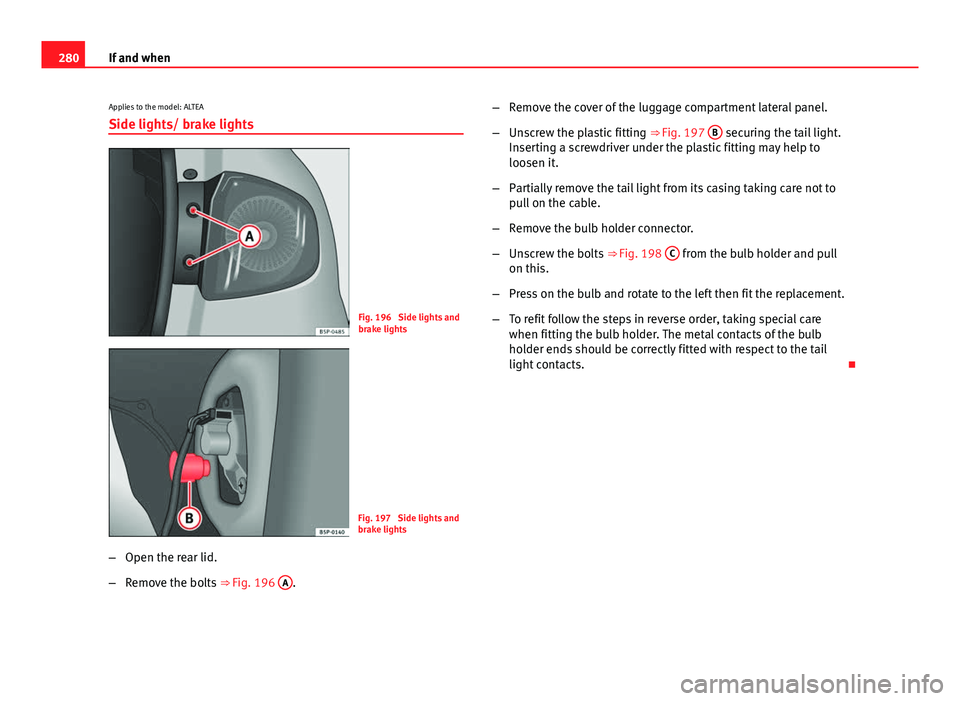
280If and when
Applies to the model: ALTEA
Side lights/ brake lights
Fig. 196 Side lights and
brake lights
Fig. 197 Side lights and
brake lights
– Open the rear lid.
– Remove the bolts ⇒ Fig. 196 A
. –
Remove the cover of the luggage compartment lateral panel.
– Unscrew the plastic fitting ⇒ Fig. 197 B
securing the tail light.
Inserting a screwdriver under the plastic fitting may help to
loosen it.
– Partially remove the tail light from its casing taking care not to
pull on the cable.
– Remove the bulb holder connector.
– Unscrew the bolts ⇒ Fig. 198 C
from the bulb holder and pull
on this.
– Press on the bulb and rotate to the left then fit the replacement.
– To refit follow the steps in reverse order, taking special care
when fitting the bulb holder. The metal contacts of the bulb
holder ends should be correctly fitted with respect to the tail
light contacts.
Page 283 of 321
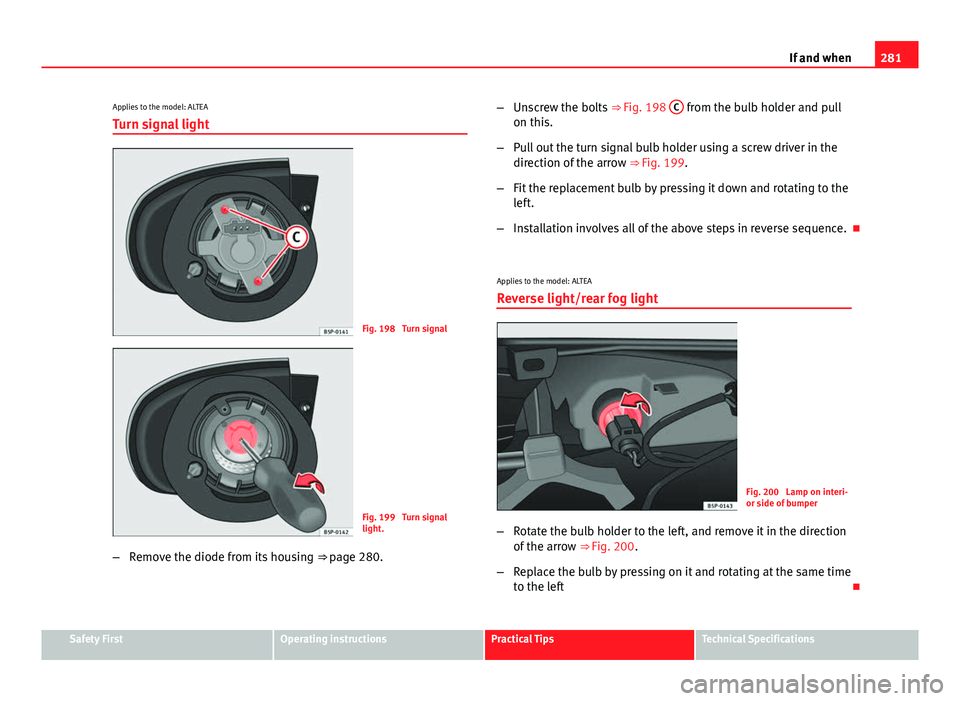
281
If and when
Applies to the model: ALTEA
Turn signal light
Fig. 198 Turn signal
Fig. 199 Turn signal
light.
– Remove the diode from its housing ⇒ page 280.–
Unscrew the bolts ⇒ Fig. 198 C
from the bulb holder and pull
on this.
– Pull out the turn signal bulb holder using a screw driver in the
direction of the arrow ⇒ Fig. 199.
– Fit the replacement bulb by pressing it down and rotating to the
left.
– Installation involves all of the above steps in reverse sequence.
Applies to the model: ALTEA
Reverse light/rear fog light
Fig. 200 Lamp on interi-
or side of bumper
– Rotate the bulb holder to the left, and remove it in the direction
of the arrow ⇒ Fig. 200.
– Replace the bulb by pressing on it and rotating at the same time
to the left
Safety FirstOperating instructionsPractical TipsTechnical Specifications
Page 284 of 321
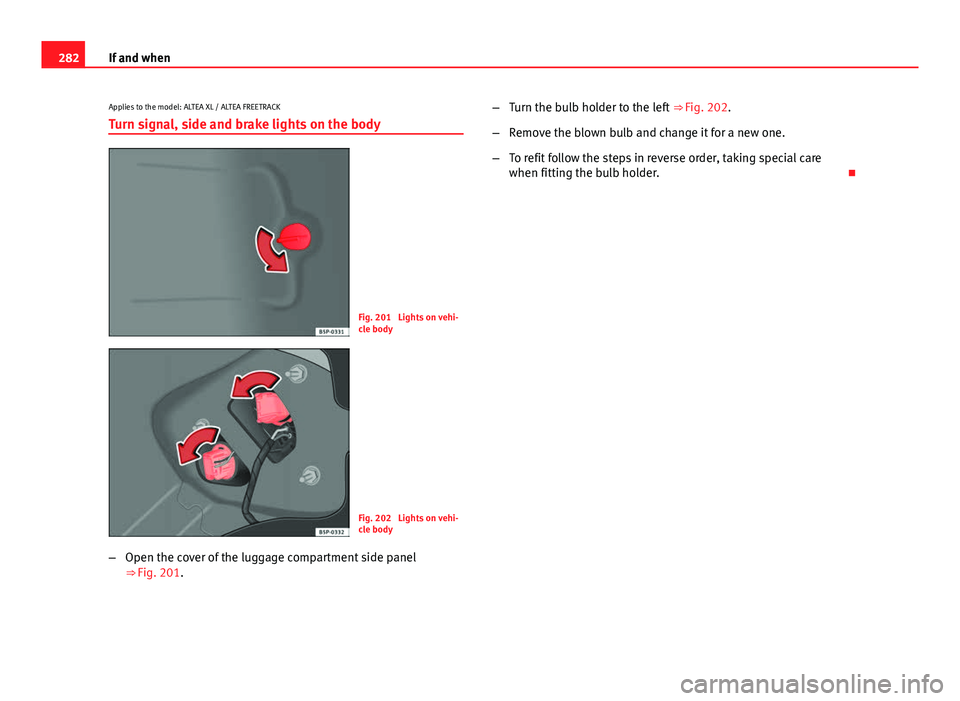
282If and when
Applies to the model: ALTEA XL / ALTEA FREETRACK
Turn signal, side and brake lights on the body
Fig. 201 Lights on vehi-
cle body
Fig. 202 Lights on vehi-
cle body
– Open the cover of the luggage compartment side panel
⇒ Fig. 201. –
Turn the bulb holder to the left ⇒ Fig. 202.
– Remove the blown bulb and change it for a new one.
– To refit follow the steps in reverse order, taking special care
when fitting the bulb holder.
Page 285 of 321
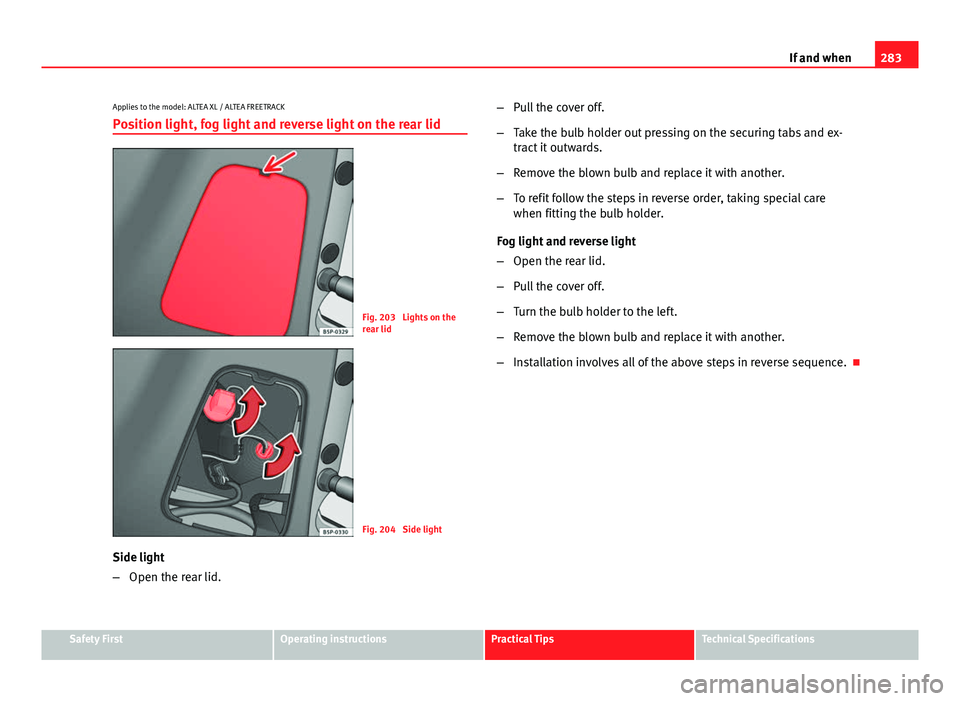
283
If and when
Applies to the model: ALTEA XL / ALTEA FREETRACK
Position light, fog light and reverse light on the rear lid
Fig. 203 Lights on the
rear lid
Fig. 204 Side light
Side light
– Open the rear lid. –
Pull the cover off.
– Take the bulb holder out pressing on the securing tabs and ex-
tract it outwards.
– Remove the blown bulb and replace it with another.
– To refit follow the steps in reverse order, taking special care
when fitting the bulb holder.
Fog light and reverse light
– Open the rear lid.
– Pull the cover off.
– Turn the bulb holder to the left.
– Remove the blown bulb and replace it with another.
– Installation involves all of the above steps in reverse sequence.
Safety FirstOperating instructionsPractical TipsTechnical Specifications
Page 286 of 321
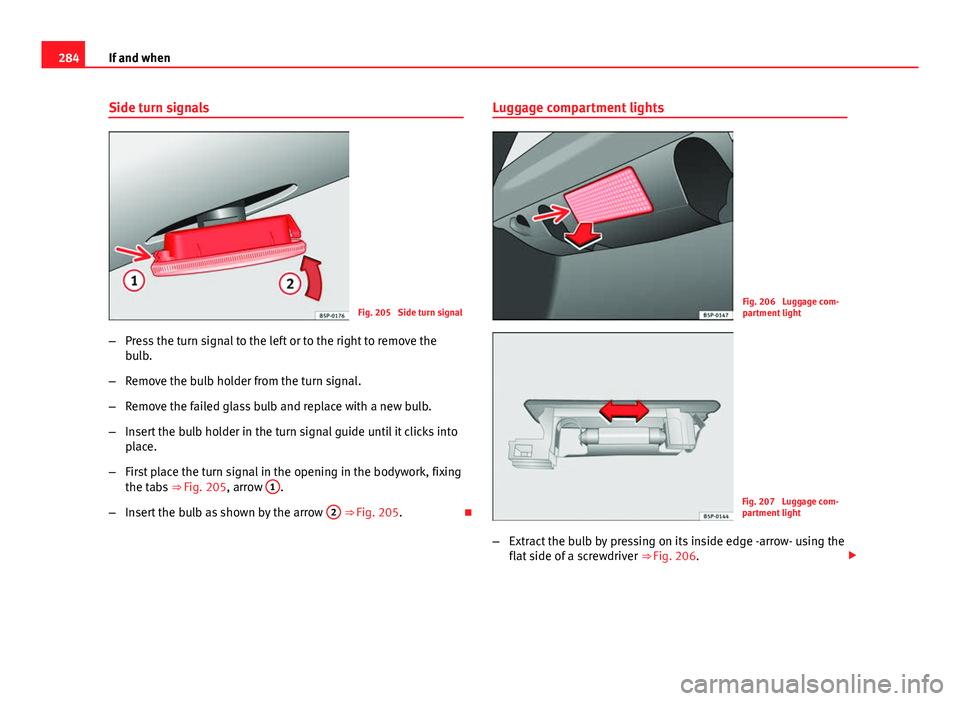
284If and when
Side turn signals
Fig. 205 Side turn signal
– Press the turn signal to the left or to the right to remove the
bulb.
– Remove the bulb holder from the turn signal.
– Remove the failed glass bulb and replace with a new bulb.
– Insert the bulb holder in the turn signal guide until it clicks into
place.
– First place the turn signal in the opening in the bodywork, fixing
the tabs ⇒ Fig. 205, arrow 1
.
– Insert the bulb as shown by the arrow 2
⇒ Fig. 205.Luggage compartment lights
Fig. 206 Luggage com-
partment light
Fig. 207 Luggage com-
partment light
– Extract the bulb by pressing on its inside edge -arrow- using the
flat side of a screwdriver ⇒ Fig. 206.
Page 287 of 321
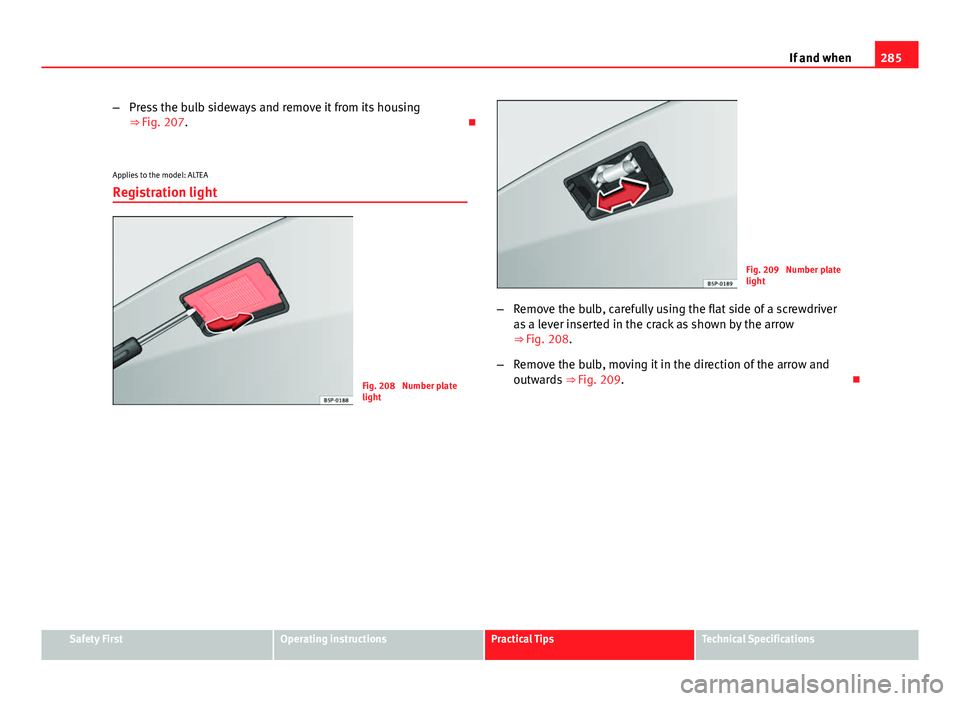
285
If and when
– Press the bulb sideways and remove it from its housing
⇒ Fig. 207.
Applies to the model: ALTEA
Registration light
Fig. 208 Number plate
light
Fig. 209 Number plate
light
– Remove the bulb, carefully using the flat side of a screwdriver
as a lever inserted in the crack as shown by the arrow
⇒ Fig. 208.
– Remove the bulb, moving it in the direction of the arrow and
outwards ⇒ Fig. 209.
Safety FirstOperating instructionsPractical TipsTechnical Specifications
Page 288 of 321
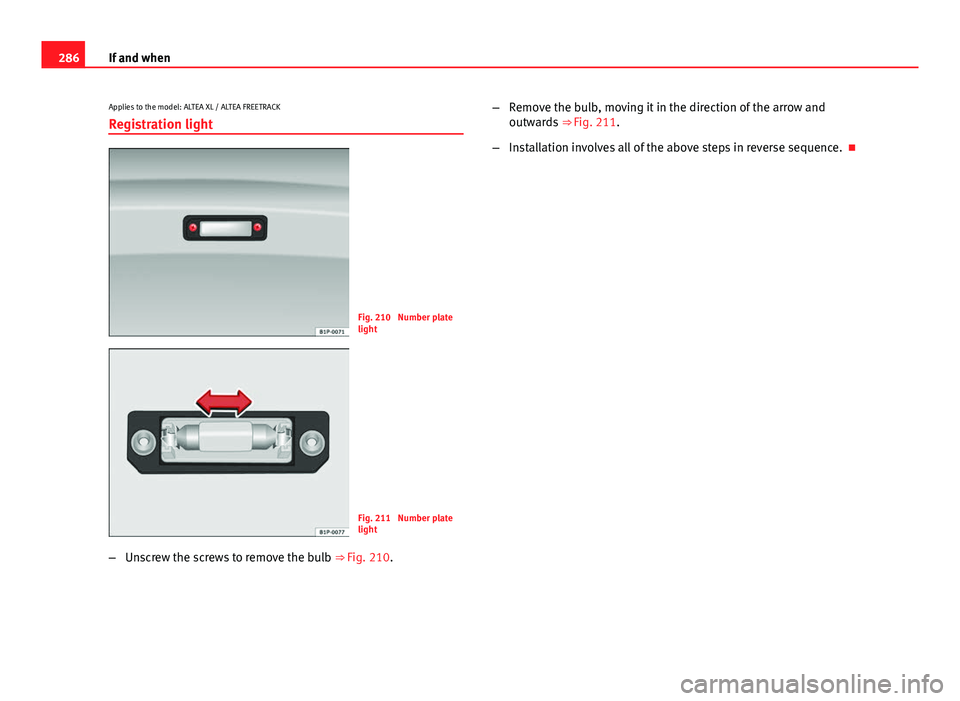
286If and when
Applies to the model: ALTEA XL / ALTEA FREETRACK
Registration light
Fig. 210 Number plate
light
Fig. 211 Number plate
light
– Unscrew the screws to remove the bulb ⇒ Fig. 210.–
Remove the bulb, moving it in the direction of the arrow and
outwards ⇒ Fig. 211.
– Installation involves all of the above steps in reverse sequence.
Page 289 of 321
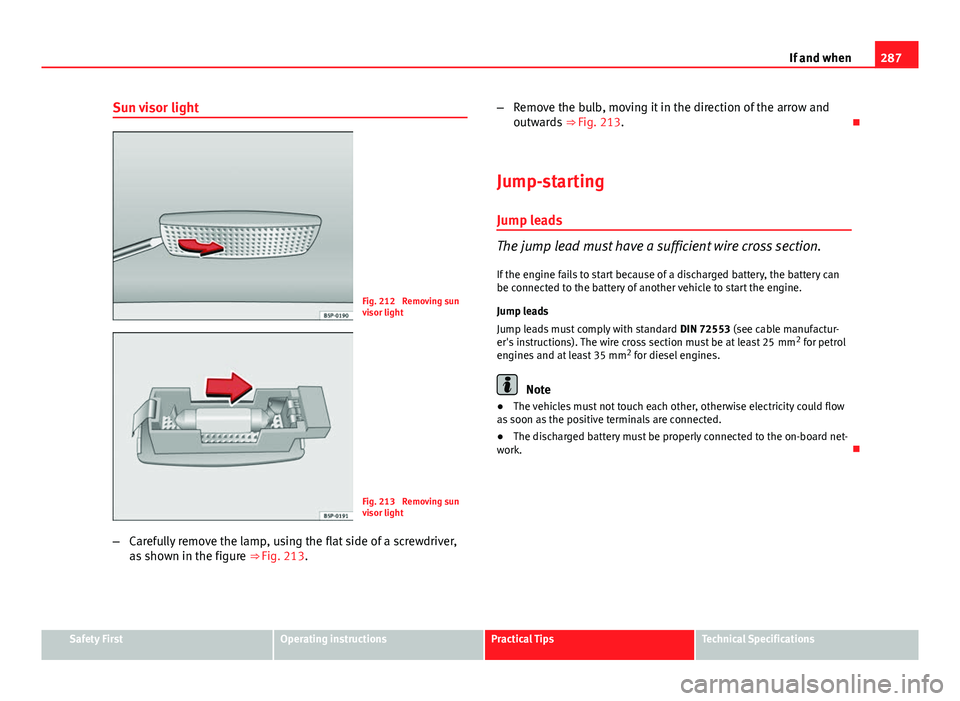
287
If and when
Sun visor light
Fig. 212 Removing sun
visor light
Fig. 213 Removing sun
visor light
– Carefully remove the lamp, using the flat side of a screwdriver,
as shown in the figure ⇒ Fig. 213. –
Remove the bulb, moving it in the direction of the arrow and
outwards ⇒ Fig. 213.
Jump-starting
Jump leads
The jump lead must have a sufficient wire cross section. If the engine fails to start because of a discharged battery, the battery can
be connected to the battery of another vehicle to start the engine.
Jump leads
Jump leads must comply with standard DIN 72553 (see cable manufactur-
er's instructions). The wire cross section must be at least 25 mm 2
for petrol
engines and at least 35 mm 2
for diesel engines.
Note
● The vehicles must not touch each other, otherwise electricity could flow
as soon as the positive terminals are connected.
● The discharged battery must be properly connected to the on-board net-
work.
Safety FirstOperating instructionsPractical TipsTechnical Specifications
Page 290 of 321
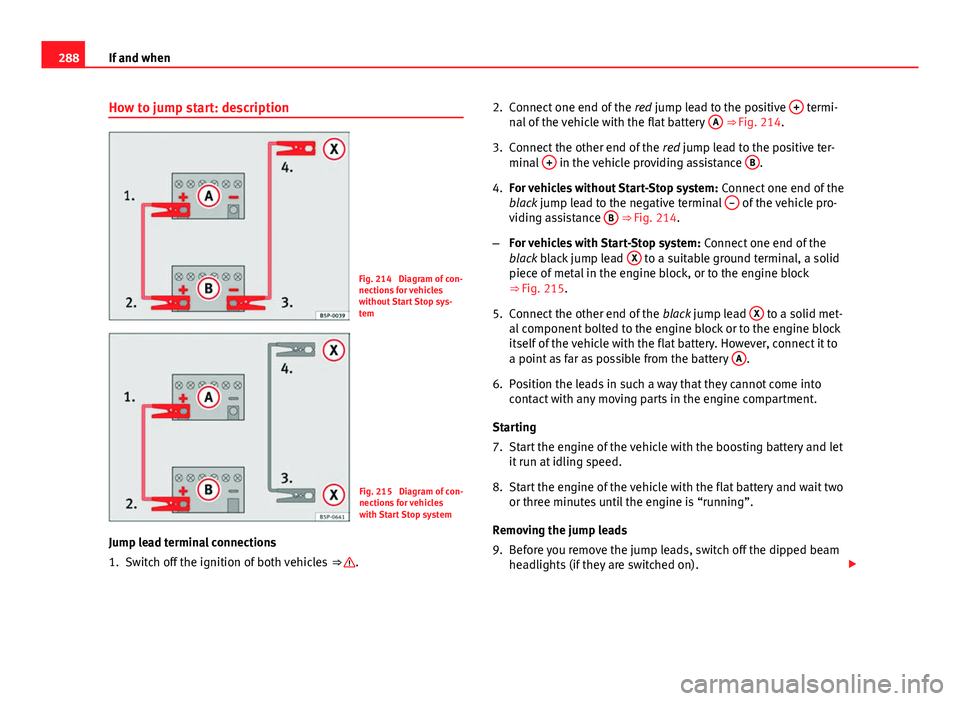
288If and when
How to jump start: description
Fig. 214 Diagram of con-
nections for vehicles
without Start Stop sys-
tem
Fig. 215 Diagram of con-
nections for vehicles
with Start Stop system
Jump lead terminal connections
1. Switch off the ignition of both vehicles ⇒
.2. Connect one end of the
red jump lead to the positive +
termi-
nal of the vehicle with the flat battery A ⇒ Fig. 214.
3. Connect the other end of the red jump lead to the positive ter-
minal +
in the vehicle providing assistance B.
4. For vehicles without Start-Stop system: Connect one end of the
black jump lead to the negative terminal –
of the vehicle pro-
viding assistance B ⇒ Fig. 214.
– For vehicles with Start-Stop system: Connect one end of the
black black jump lead X
to a suitable ground terminal, a solid
piece of metal in the engine block, or to the engine block
⇒ Fig. 215.
5. Connect the other end of the black jump lead X
to a solid met-
al component bolted to the engine block or to the engine block
itself of the vehicle with the flat battery. However, connect it to
a point as far as possible from the battery A
.
6. Position the leads in such a way that they cannot come into contact with any moving parts in the engine compartment.
Starting
7. Start the engine of the vehicle with the boosting battery and let it run at idling speed.
8. Start the engine of the vehicle with the flat battery and wait two or three minutes until the engine is “running”.
Removing the jump leads
9. Before you remove the jump leads, switch off the dipped beam headlights (if they are switched on).
Page 291 of 321
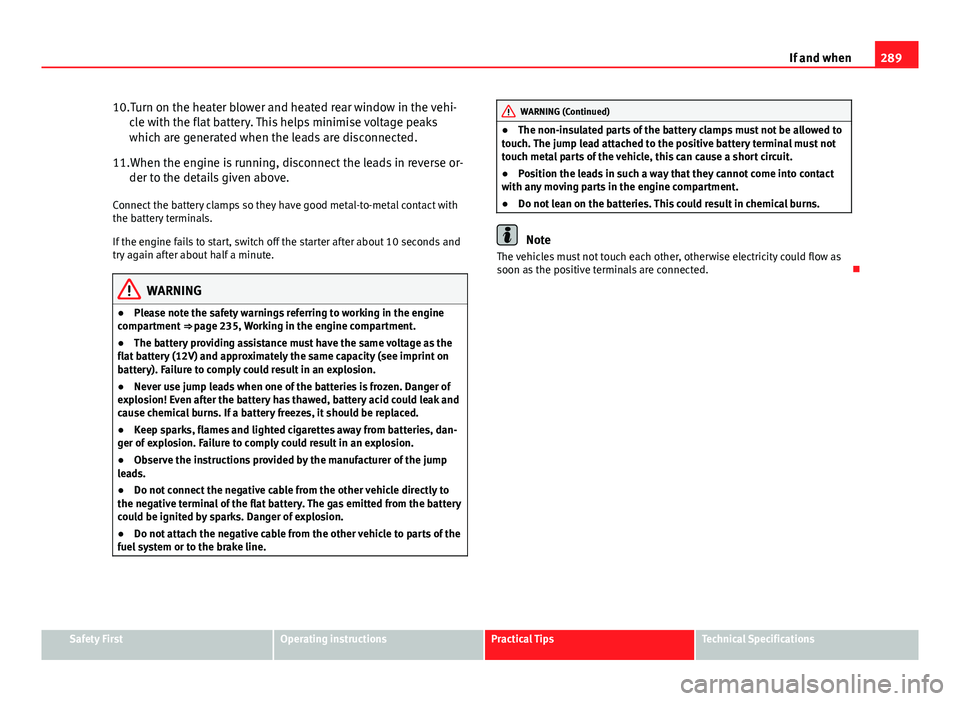
289
If and when
10.Turn on the heater blower and heated rear window in the vehi- cle with the flat battery. This helps minimise voltage peaks
which are generated when the leads are disconnected.
11.When the engine is running, disconnect the leads in reverse or- der to the details given above.
Connect the battery clamps so they have good metal-to-metal contact with
the battery terminals.
If the engine fails to start, switch off the starter after about 10 seconds and
try again after about half a minute.
WARNING
● Please note the safety warnings referring to working in the engine
compartment ⇒ page 235, Working in the engine compartment.
● The battery providing assistance must have the same voltage as the
flat battery (12V) and approximately the same capacity (see imprint on
battery). Failure to comply could result in an explosion.
● Never use jump leads when one of the batteries is frozen. Danger of
explosion! Even after the battery has thawed, battery acid could leak and
cause chemical burns. If a battery freezes, it should be replaced.
● Keep sparks, flames and lighted cigarettes away from batteries, dan-
ger of explosion. Failure to comply could result in an explosion.
● Observe the instructions provided by the manufacturer of the jump
leads.
● Do not connect the negative cable from the other vehicle directly to
the negative terminal of the flat battery. The gas emitted from the battery
could be ignited by sparks. Danger of explosion.
● Do not attach the negative cable from the other vehicle to parts of the
fuel system or to the brake line.
WARNING (Continued)
● The non-insulated parts of the battery clamps must not be allowed to
touch. The jump lead attached to the positive battery terminal must not
touch metal parts of the vehicle, this can cause a short circuit.
● Position the leads in such a way that they cannot come into contact
with any moving parts in the engine compartment.
● Do not lean on the batteries. This could result in chemical burns.
Note
The vehicles must not touch each other, otherwise electricity could flow as
soon as the positive terminals are connected.
Safety FirstOperating instructionsPractical TipsTechnical Specifications